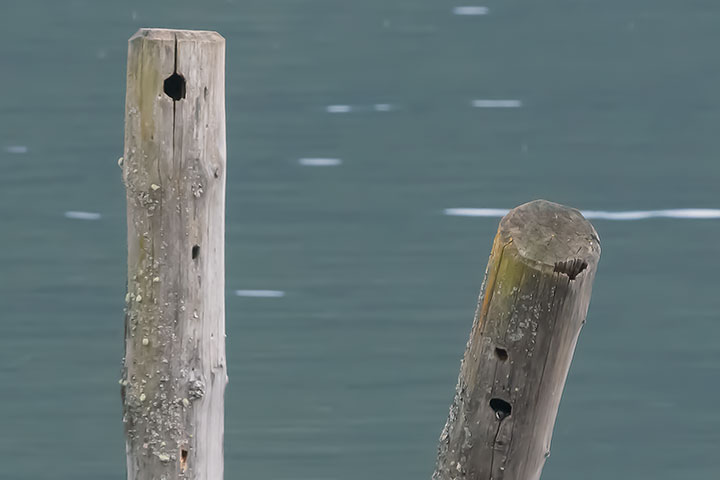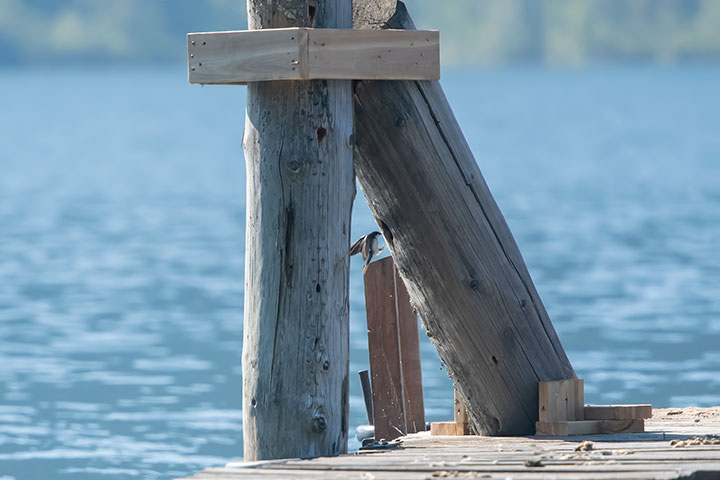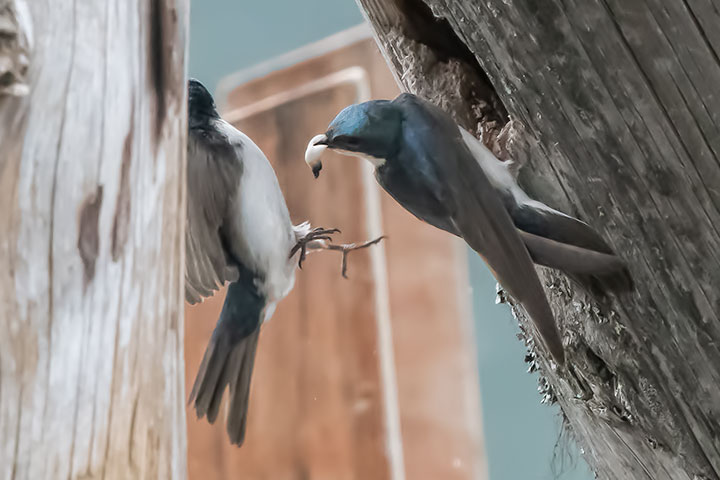Tree Swallows often nest in the cavities that Northern Flickers have carved in the pilings of docks.
A person commits an offence if the person … possesses, takes, injures, molests or destroys a bird or its egg. BC Wildlife Act.
But in mid-June, one of those pilings had rotted at the waterline. It then broke in two, and its upper portion began to cant dangerously. The broken portion was only stopped mid-descent by the stirrup that loosely held it to the dock.
However, the Lake was going down. It wouldn’t be long before the dock and its stirrup would drop below the broken piece causing the piling top to fall into the water and drift off. This would be bad on two counts:
• a broken piling floating among boat traffic poses a danger;
• the piling’s active nest of Tree Swallows would be destroyed.
Clearly, the broken piling had to be removed before it fell into the water. But, how was this to be done in the light of an active bird’s nest? Moving the nest and disturbing those birds would violate the wildlife act. And if it were moved, would the swallows accept the new location and continue incubating their eggs? Even if the swallows were to accept the new location, would the eggs have survived the double whammy of the break of the piling, and its subsequent move?
This was tricky. Three pictures tell the story.
A piling had rotted at the waterline, and two-and-a-half weeks ago, a storm had caused it to break. The portion above the waterline tipped but was held precariously by the stirrup loosely adhering it to the dock. As the water level was dropping, this momentary reprieve would soon end causing the piling to fall into the Lake and to drown the nest. A swallow can be seen looking out of the cavity.

A couple of days after the break, the top of the piling was cut off well below the cavity but above the waterline. It was then set on the dock at about the same sloping angle, and loosely attached to the adjacent piling with a collar which allowed it move down as the water level dropped. During the hour and a half it took to do all this, the Tree Swallows agitatedly flew in circles around the operation. However, the following morning, when this picture was taken, the swallows had accepted the new location and were again tending the nest. This part was a success, but did the eggs survived the break and the move? There was nothing to do but wait.

Two-and-a-half weeks went by. Even though the adults continued to occupy the cavity, there was no way to know if the eggs had actually survived. We would have to wait to see if chicks poked their heads out — or that was the thinking until unexpectedly the swallows offered early irrefutable evidence that at least one chick was doing well: a faecal sac. The picture shows the female flying towards the cavity while the male removes the poop from one of the chicks. It will be fun to see chicks when they emerge, but, for now, everything is looking good.

In the time that has passed since the piling broke, the Lake level has, indeed, dropped. Had nothing been done, the piling would have fallen, drifted off, and drowned the nest. Maybe the offence of briefly molesting these nesting birds can be forgiven.

Well done Alistair
Here’s to the observant naturalist, and willing saver of a nest of baby swallows!
Thanks for this lovely story, Karen. Tender care for the birds, and their courage to accept help.
This was great thank you! The birds are protected under the Migratory Birds Convention Act (a federal treaty with Mexico and USA) not under the BC Wildlife Act (resident birds)
Either way, I don’t think anyone official would ding you for saving a nest from imminent danger which, as you say, would have wiped them out for sure. Way to go!
Max, I knew about the treaty, but it is also in the BC Wildlife Act, as I claimed.
What is?
The Wildlife Act prohibits the taking, possessing, or destroying of eggs and nests in BC. You did none of this. The Federal Act prohibits interfering with the nesting of migratory birds which technically you did do, but of course it was to preserve the lives of the birds so i doubt this was even illegal.
Max, thank you for that distinction.
Very nicely done Alistair.
A heart warming story . thank you .